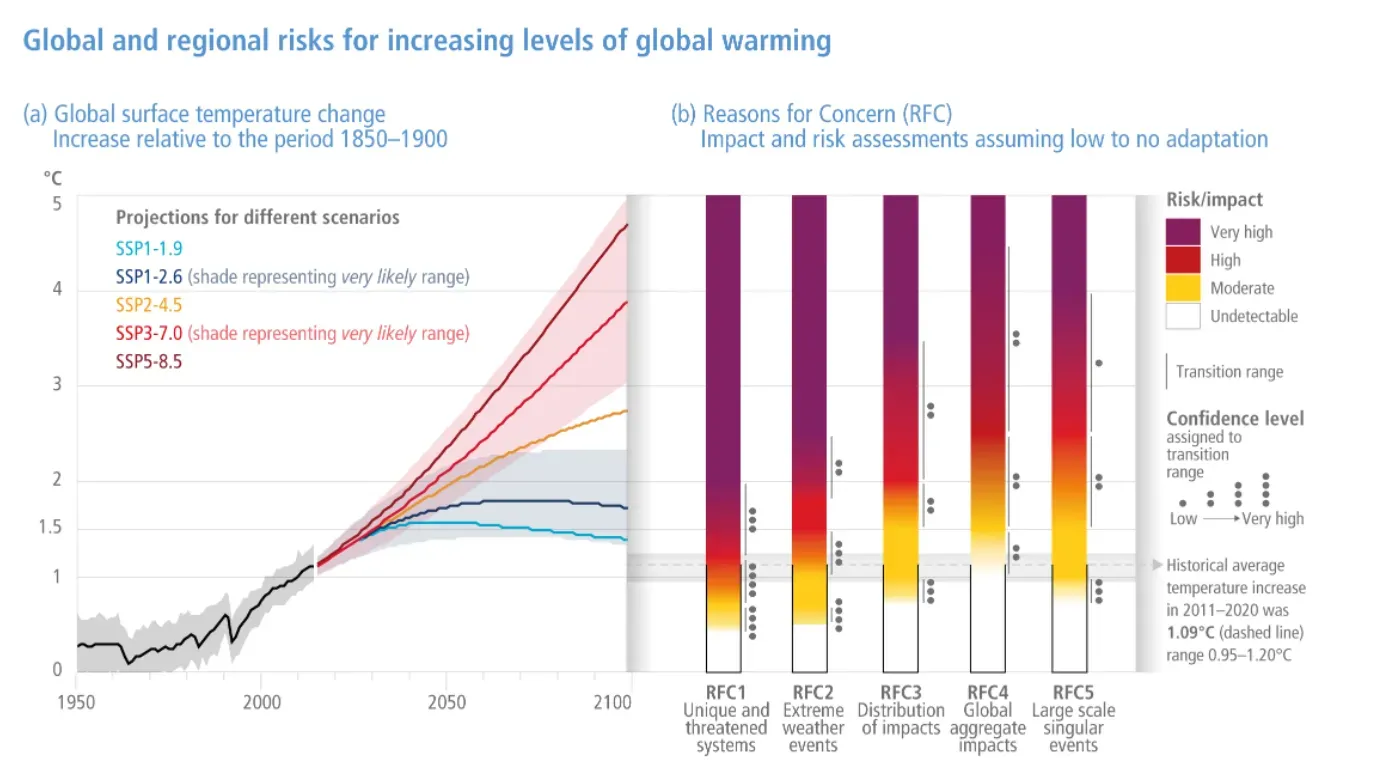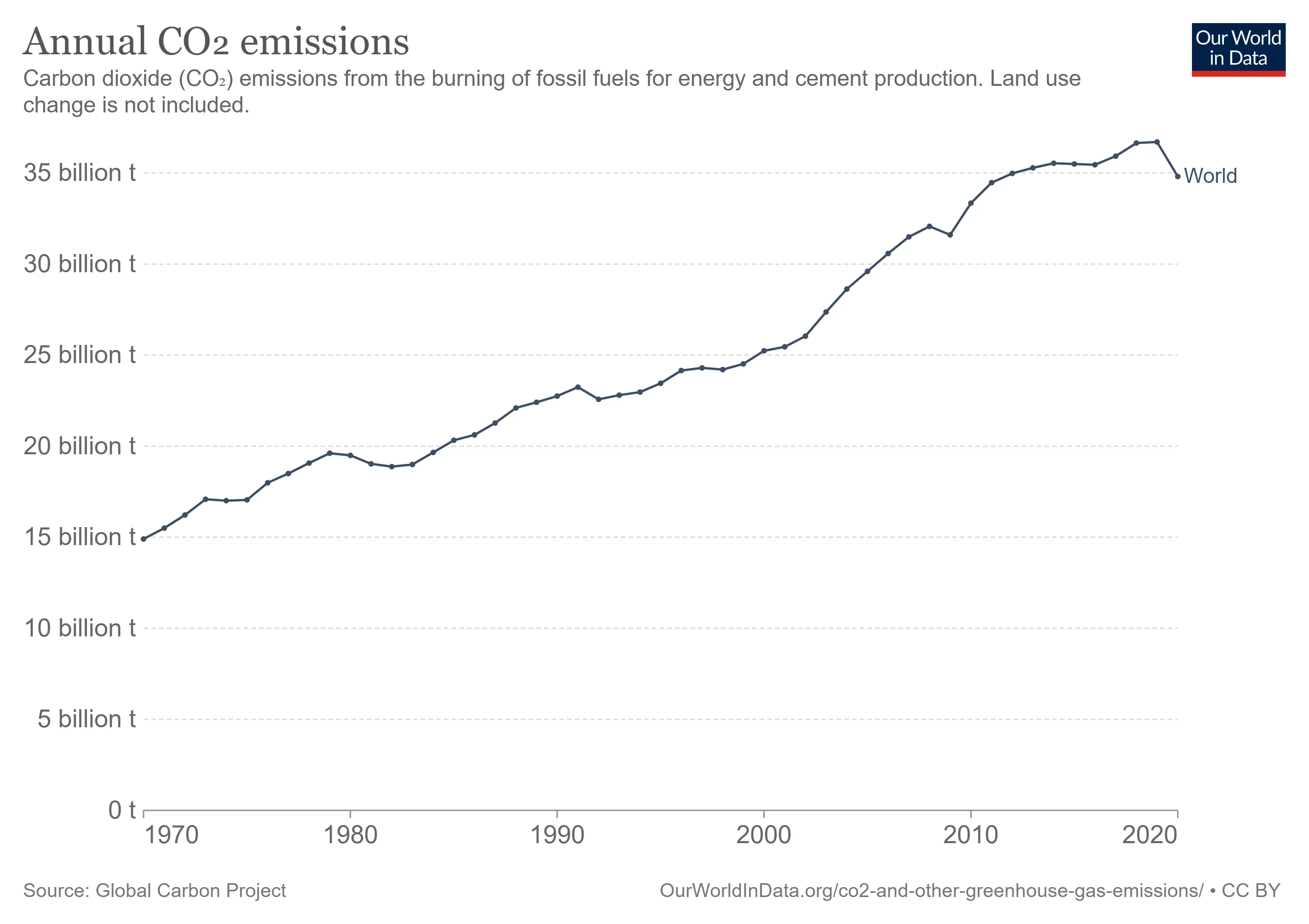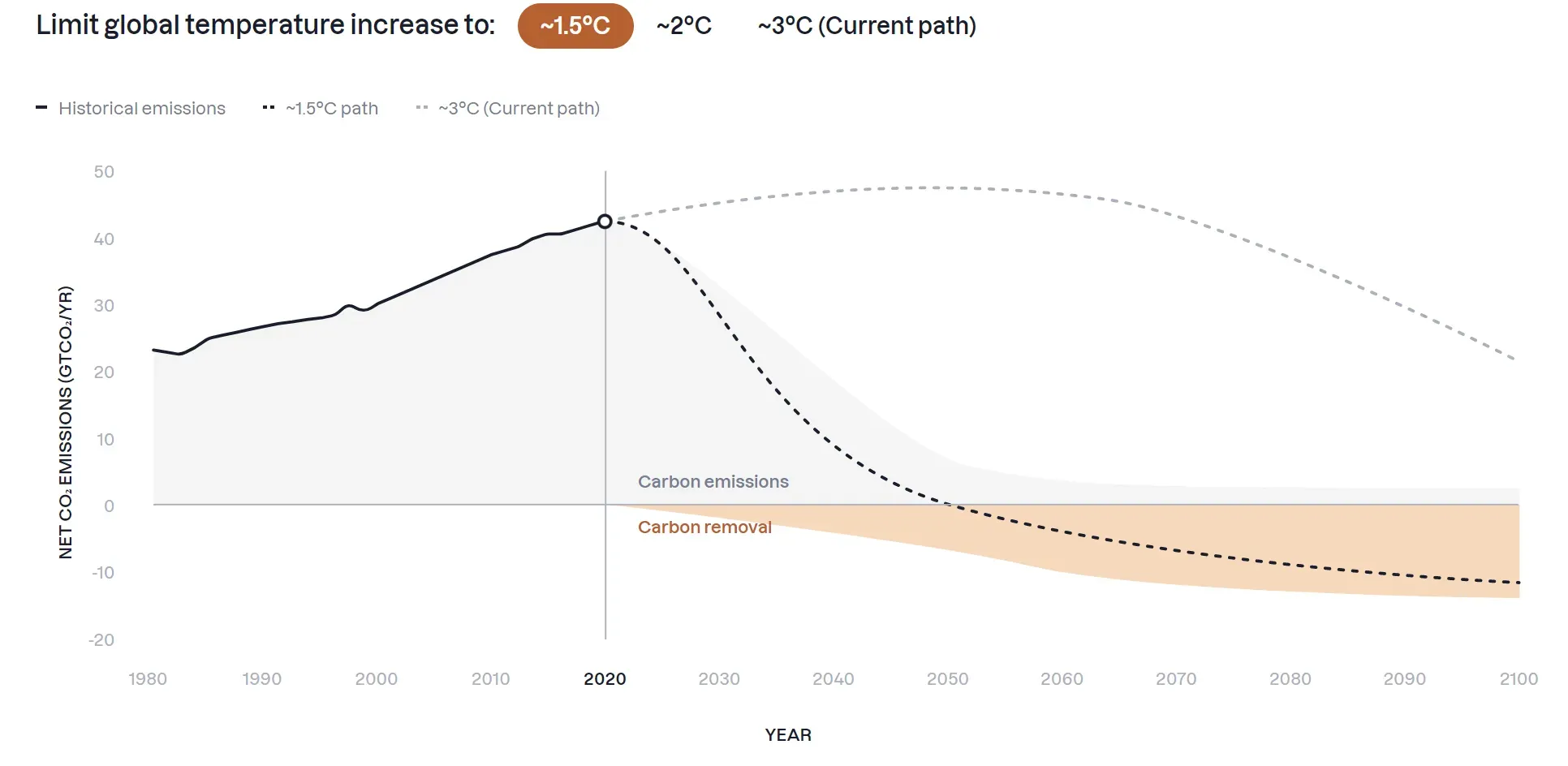As of 2022, our planet has warmed by an average of 1°C (1.8°F) since the industrial revolution (1760 — 1840), with most of that happening in the last century. While this might not sound like very much, there is a strong scientific consensus that this warming is already leading to an increased frequency and intensity of extreme weather events such as heat waves, tropical storms, and wildfires.
The primary driver of global warming is the emission of heat-trapping gasses into the atmosphere. The primary culprit is carbon dioxide (although methane, nitrous oxide, and several others also play a role). Carbon dioxide, or CO₂, is emitted into the atmosphere from a wide range of human activities as well as some natural processes and much of this carbon dioxide is also removed through natural processes as part of the carbon cycle.
When the oceans absorb CO₂, they become more acidic, which harms sea life. Since pre-industrial times, the oceans have absorbed approximately 152 gigatons of CO₂.
When plants absorb CO₂, they use the carbon atoms as building materials to grow new cells or make simple sugars. This is a great natural carbon sink, but plants also give off carbon when they decompose or burn.
The Intergovernmental Panel on Climate Change (IPCC) has determined that 2 degrees of global warming is the upper “safe” limit. Any warming beyond this limit will almost certainly result in serious negative outcomes.

The good news
While the assessment report was the gravest yet, there are pathways to keeping warming to within 1.5 degrees this century. If achieved, it would offer the greatest possible opportunities for building climate resilience and meeting the world’s sustainable development goals.
However, in order to limit warming to just 1.5 degrees, the IPCC report stresses that we will need to develop and use carbon dioxide removal (CDR) technologies.
We can’t just stop emitting carbon. We need to start the process of drawing down what has already been emitted.
The good news is that annual CO₂ emissions have largely leveled off and have remained flat for the last decade. With the exception of China and India, emissions worldwide have started to decline.

Under increasing pressure from their citizens, governments are setting ambitious emissions targets, phasing out internal combustion engine vehicles, shifting energy generation towards renewables, and aiming for net zero emissions by 2050.
The year 2022 has turned out to be a watershed moment in climate financing with the formation of Frontier, an advance market commitment (AMC) to purchase close to $1 billion worth of permanent carbon removal between 2022 and 2030. It is funded by Stripe, Alphabet, Shopify, Meta, McKinsey, and thousands of small businesses using Stripe Climate.
At the same time, climate technology startups are raising hundreds of millions in venture capital to fight climate change. Why would investors give money to climate startups? Because there is an estimated $6 trillion market for carbon removal. Whereas carbon dioxide used to be a waste product vented to the atmosphere, recent technological innovations can convert this waste product into something valuable: fuels, chemical feedstocks, plastics, and building materials.
Carbon technologies create the possibility of getting rich by saving the planet. Never has there been a better alignment of incentives in the history of capitalism.
The XPRIZE Carbon Removal competition has a prize purse of $100 million that will be disbursed to the winning companies that can demonstrate a viable innovation capable of achieving gigaton scale with durable carbon storage of at least 100 years. The top 15 companies were recently awarded “milestone” prizes of $1 million. The final winners will be announced in 2025.
Technological solutions to climate change
To limit global warming to within 1.5 degrees, the world needs to rapidly reduce its dependence on fossil fuels as well as deploy innovations that can permanently remove carbon dioxide.
This next section focuses on what some of those innovations will look like.

Carbon capture and sequestration (CCS)
There are a number of industries that are very difficult to decarbonize, such as the production of cement and steel, responsible for 8% and 9%, respectively, of total carbon emissions.
For energy generation, natural gas peaker plants will likely continue to play an important role in stabilizing the power grid as more renewable energy sources come online.
In the production of fertilizer, hydrogen is a vital feedstock, which today is largely produced by reforming methane in a process that emits CO₂.
Humanity will likely depend on each of these sectors for the next few decades until technological innovation can deliver zero-carbon alternatives. In order to negate their emissions, waste gases can be fed into carbon capture devices that separate out the pollutants. These are then permanently sequestered underground in rock formations.
CCS adds to the costs of these industries and without regulation or a robust market for carbon, companies are unlikely to perform the retrofits voluntarily.
One example company working on making CCS affordable and scaleable is Aker Carbon Capture.
Direct air capture (DAC)
Whereas CCS captures carbon from concentrated sources, direct air capture works to scrub the atmosphere. The average concentration of carbon dioxide in the atmosphere is about 415 parts per million (ppm), or about 0.04%. The concentration just prior to the industrial revolution was about 278 ppm.
DAC aims to perform the same function as trees, but at a much faster rate and using a fraction of the land. A DAC facility can be constructed anywhere in world and powered by renewable energy.
Most DAC techniques involve mechanically blowing ambient air through a filter where the CO₂ molecules are captured. In one technique, a liquid solution of calcium hydroxide is used. This chemical solvent reacts with CO₂ to form calcium carbonate (limestone), which is stable and be used to store carbon permanently.
There are many startups in this space, the largest of which can capture kilotons per year. There are several other facilities under construction that aim to capture in excess of 1 MT.
The cost per ton of captured carbon is still very high, around $200–600/ton, but the technology is still nascent, and many different approaches are currently being tried. Improvements in energy efficiency, chemical adsorbents, and catalysts will likely drive costs down toward around $100/ton.
Companies working in this space include: Climeworks, Carbon Engineering, Sustaera, Project Hajar, Verdox, Global Thermostat, Carbon Collect MechanicalTrees, Calcite by 8Rivers, Carbyon, and others.
An important enabler to permanent sequestration is Carbfix, which has developed technology and established sites for injecting a dissolved CO₂ solution into rock formations deep underground, where the carbon gradually solidifies.
Enhanced weathering and mineralization
The idea behind enhanced weathering is to accelerate Earth’s natural carbon cycle. Rocks and minerals exposed to air and water naturally react with carbon dioxide to form carbonates, which are solid and stable. This is also called mineralization. When this occurs in the ocean, the carbonates sink to the ocean floor.
The oceans are an important carbon sink, and currently absorb most of the carbon emitted to the atmosphere. This has helped to slow the rate of global warming, but is slowly causing our oceans to become more acidic. If this process continues, many ocean organisms that form hard shells from calcium will die because these shells dissolve in water that is too acidic. Ocean mineralization has the secondary advantage of balancing pH levels.
To accelerate the carbon removal process, some companies are grinding down certain minerals (like basalt) into something resembling aggregate or sand. This can then be safely spread around coastlines or even on forest floors where water and air will react with it.
The advantage of this approach is that it can be relatively cheap. It even has the potential to improve soil quality. When performed with ocean water, it has the secondary advantage of reducing ocean acidity. Questions remain as to how much carbon can be removed in this way and how quickly. There are also concerns about the potential environmental impacts resulting from the mining of these minerals.
Some companies focused on mineralization or enhanced weathering: Project Vesta, Patch, Carbfix, Heirloom, Carbon8, Ebb Carbon, Eion, Planetary, Lithos Carbon.
Bio-oil and BECCS
All of the hydrocarbons extracted from underground and burned for fuel original came from prehistoric vegetation, long buried and converted to coal or oil through heat and pressure. It should therefore be possible to convert harvested plant matter into energy-dense fuels today using the right chemical or industrial processes. And since growing plants removes carbon from the atmosphere, these fuels are theoretically net-zero. When bio-energy (BE) is combined with carbon capture and sequestration (CCS) you get BECCS.
Versions of this technology are already widely used. In some parts of the world, diesel fuel is mixed with vegetable oil to reduce its carbon intensity. Gasoline can be mixed with ethanol. Sustainable aviation fuel (SAF) is a 100% biologically-derived kerosene-like alternative to jet fuel. When burned during a flight, it releases carbon into the atmosphere that was originally removed by the plants grown to make the fuel. Thus, it is close to net-zero emissions.
There are some unresolved issues with this approach. Biofuels are still much more expensive that their fossil counterparts, so it can be difficult to create markets for them. If crops grown for fuel displace crops grown for food, it results in higher food prices and could contribute to food insecurity. This, in turn, can lead to further deforestation to create more room for crops.
Thankfully, there are companies working to solve these problems. One example is Charm Industrial, which can make bio-oil using farm waste and other biomatter that can be grown on land not suitable for agriculture. Their solution can also be used for pure carbon sequestration if the resulting bio-oil is pumped underground into porous rock formations or exhausted oil wells.
Some organizations working on BECCS and related ideas: Charm Industrial, Bioeconomy Institute Carbon Removal Team from Iowa State University, Drax, Arbor, Yale Carbon Containment Lab, Kodama.
Natural approaches to carbon removal
In this article, I’ve focused on technological methods of removing atmospheric or ocean carbon. I haven’t addressed several nature-based solutions, such as changes in land use or reforestation. These hold great potential for capturing and storing carbon, improving biodiversity, and slowing emissions.
None of the technical solutions described above are silver bullets. While each has its advantages, each also comes with inherent costs, scaleability issues, or side effects. That is unfortunately true of many nature-based solutions as well.
For example, planting trees has been touted as a common-sense climate change solution, but trees only retain carbon on timescales of decades and a single wildfire can undo years of carbon sequestration. Finding suitable areas for billions of trees to be planted reduces the total amount of land available for growing food. Planting trees where there were previously none (afforestation) can perturb existing ecosystems and change the Earth’s reflectivity (albedo), leading to more warming.
Nature-based approaches to carbon removal deserve their own article and are a vital part of the equation. The world needs to pursue both natural and technological means of carbon removal in order to reach net zero by mid-century and stabilize the climate by the end of the century. Each approach needs thoughtful consideration and implementation.